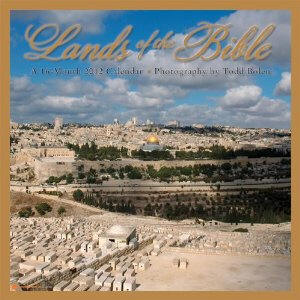|
BiblePlaces Newsletter
Vol 10, #2 - November 9, 2011
Great photos are the theme of this newsletter. We begin with a notice
about two beautiful calendars with photos of biblical sites. We continue
with an announcement that our resources are now more widely available
around the world with the addition of our Spanish version of
BiblePlaces.com. And we conclude with our favorite photos from the best
viewpoints in all of Israel.In our most recent
newsletter (way back in
May)
we indicated that we would have a big announcement at the end of the
summer. It turns out that we were too optimistic about our ability to
work fast, especially when dealing with quantities higher than 10,000. We
anticipate completion of our best project ever sometime after the New
Year. The next newsletter should have all of the details, but the
featured photos below will give you a preview.
Finally, if you see me next week at the annual meeting
of the Evangelical Theological Society in San Francisco, say hello and
ask what's in my bag.
Todd Bolen
Editor, BiblePlaces.com and
LifeintheHolyLand.com
2012 Calendars
Our photos are featured in a
couple of calendars for the coming year. Recently on the blog,
we recommended the calendar from Lamb and Lion Ministries with the
theme of the "Galilee of Jesus" (available for
$5 here). A second calendar entitled "Lands of the Bible" has been
produced by Orange Circle Studio. This collection of
many of my favorite photographs is available in retail stores around
the United States as well as from Amazon ($11
here). The calendar includes two photographs each month of such
places as Jerusalem, En Gedi, the Wilderness of Judah, Ephesus, Corinth,
and Rome. These calendars make affordable and attractive gifts that will
please the recipient all year long.
Recently on the blog,
we recommended the calendar from Lamb and Lion Ministries with the
theme of the "Galilee of Jesus" (available for
$5 here). A second calendar entitled "Lands of the Bible" has been
produced by Orange Circle Studio. This collection of
many of my favorite photographs is available in retail stores around
the United States as well as from Amazon ($11
here). The calendar includes two photographs each month of such
places as Jerusalem, En Gedi, the Wilderness of Judah, Ephesus, Corinth,
and Rome. These calendars make affordable and attractive gifts that will
please the recipient all year long.
BiblePlaces.com—in
Spanish
We have been developing
LugaresBiblicos.com for
several years and the website is now online and available to users
throughout the Spanish-speaking world. Everything has been translated by
an expert with results far superior to what one gets from an internet
translation service.
If you have friends who would benefit from this
resource, or if you have a website/blog, we would greatly appreciate it
if you spread the word about
LugaresBiblicos.com.
Not quite so new, but still worthy of attention is the
French version at BibleLieux.com.
News from the BiblePlaces Blog...
Weekend Roundup - Our collection of stories last weekend
included a link to a free electronic copy of Ancient Israel:
Highlights from the Collections of the Oriental Institute University of
Chicago...
A New Proposal for Israel's Stonehenge - One scholar has
proposed that a structure of concentric stone circles in the Golan
Heights was used for excarnation...
Western Wall Bridge Deemed a Safety Hazard - The temporary
wooden bridge providing non-Muslims with the only access to the Temple
Mount must go, says Jerusalem's engineer...
InscriptiFact: A Better Way to Read Inscriptions - Light changes
everything, and now you can change the light without even being in the
same room as the ancient artifact...
Underground to the Western Wall - The latest tourist attraction
in Jerusalem is illustrated and described at length by Tom Powers...
New Book: Archaeology in the Israel Museum - This book takes the
reader on a tour of some of the most significant discoveries in the new
archaeology wing...
And more...
Featured BiblePlaces Photos:
Favorite Views in Israel
My favorite spots in Israel
are those where I can "see it all." By "all" I am referring to
history, though if a history-rich scene is also beautiful, I enjoy
it even more. For the featured photographs this month, I have
collected the best shots from my favorite vantage points in Israel.
Each of these viewpoints overlooks the locations of multiple
biblical stories. If you have been to Israel but have not been to
each of these places, I would encourage you to make a note to get
there on your next trip.
While we always feature the
photographs in PowerPoint format in addition
 to
the standard jpg format, for this particular collection we highly
recommend that you download the "Favorite
Views in Israel" PowerPoint presentation (2.3 MB) so that
you can see the labeled versions of the
images. A limited version is also available
in pdf format. to
the standard jpg format, for this particular collection we highly
recommend that you download the "Favorite
Views in Israel" PowerPoint presentation (2.3 MB) so that
you can see the labeled versions of the
images. A limited version is also available
in pdf format.
Readers are
welcome to use these images for personal study and teaching.
Commercial use requires separate permission. For more
high-quality, high-resolution photographs and illustrations of biblical
sites, purchase the
Pictorial Library of
Bible Lands or the
Historic Views of
the Holy Land collections. |

